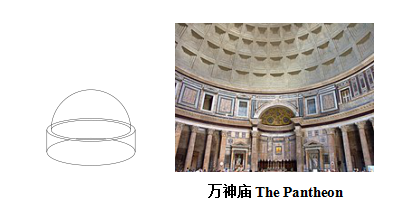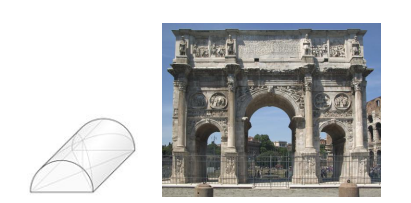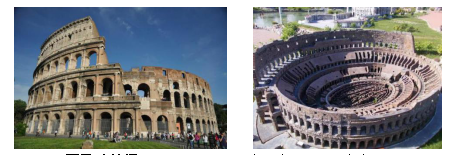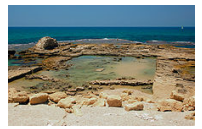托福听力中的难点话题-古罗马混凝土建筑
作者:托福听力 熊瑛
以“古罗马混凝土建筑”为相关话题的讲座出现在4月13日托福听力考题中,回溯2018年的考情分析我们不难发现,建筑类话题的考频在慢慢上升,讲座内容也融合了艺术史中的绘画、雕塑等相关知识。古罗马建筑技术上最为关键的贡献之一就是发明了罗马混凝土( Roman Concrete)。全新的建材和结构方式不仅改变了建筑的外观,塑造了前所未有的室内空间,而且影响了居民的生活方式,成为帝国兴建殖民城市的技术基础。下面我们通过介绍古罗马混凝土建筑的相关知识及其对现代建筑材料耐久性与环保方面的启示,帮助大家以点及面熟悉该领域听力材料,做题时更从容淡定。
一、背景知识及相关表达
古罗马建筑(Ancient Roman architecture),指由古罗马人创造并且扩展到地中海(the Mediterranean)沿岸其所控制疆域的一种新风格的建筑艺术,在罗马共和国(Roman Republic,509 BC~27 AD)到后期罗马帝国( Roman Empire,27 AD - 476 AD)期间繁荣发展(flourish)。古罗马建筑直接继承了古希腊晚期的建筑成就,而且将其向前大大推进,使之在公元1到3世纪达到奴隶制时代世界建筑的顶峰,且许多现存建筑均来自于帝国时期(Roman imperial period,In historiography 27 BC - 284AD)。古罗马建筑使用了混凝土以及拱券(arch)和圆顶( dome)等新技术,且设计精良。下面我们着重介绍混凝土建筑相关知识。
1. 石与砖
罗马地区大理石(marble)较少,因此在公元前2世纪开始从希腊进口大理石。罗马人非常喜欢豪华的进口彩色大理石和花式纹理( fancy veining),最重要的建筑物内部(interior)经常以大理石板(slab)镶面(facing)。大约在罗马帝国时期,人们开始生产烧制粘土砖 (fired clay brick),取代了早期晒干的泥砖(sun-dried mud-brick )。在公元1世纪,罗马人完善了制砖工艺(brickmaking skill),并将工艺传给当地居民,因此在公共和私人建筑中砖块无处不在(ubiquitous)。

Close-up view of the wall of the Roman shore fort at Burgh Castle, Norfolk,
showing alternating courses of flint and brickwork.
2. 混凝土——罗马建筑革命
罗马混凝土(Roman concrete),拉丁文为“opus caementicium”,
以水硬性水泥(hydraulic-setting cement)为基础。尽管混凝土在美索不达米亚已经被小规模使用,但罗马建筑师完善了罗马混凝土并将其用于建筑物中。与含有硅酸盐水泥(silicate cement,国际上称波特兰水泥Portland cement)的现代混凝土不同,罗马混凝土中加入了意大利半岛 (Italian peninsula)盛产的被称为“Pozzolana”或“pit sand”的火山灰( volcanic ash),可以防止裂缝(crack)扩散,因而具有耐久性(durablity)。这种火山灰砂浆具有高含量的氧化铝 (alumina)和二氧化硅( silica)。此外,与任何混凝土一样,罗马混凝土由骨料和水硬性砂浆 (hydraulic mortar)组成,水硬性砂浆是一种与水混合后随着时间的推移变硬的粘合剂(binder),其中包含的骨料纷繁多样,包括来自于已拆毁建筑物(previously demolished buildings)的残余岩石、陶瓷片(ceramic tile)以及碎砖骨料(brick rubble)。此外,凝灰岩(tuff)也经常被用作骨料。这些骨料通常比现代混凝土的要大很多,因此罗马混凝土是铺设( laid)而不是浇筑(poured)。
混凝土快速取代砖作为主要建筑材料,随后出现的建筑物以立柱 (pillar)支撑宽拱劵(broad arches)和圆顶,而不是密集的悬挂平楣 (columns suspending flat architrave)。混凝土的自由度也促进了柱廊(colonnade screen: a row of purely decorative columns in front of a load-bearing wall)建筑的发展。在较小规模的建筑中,混凝土的强度(strength)将楼层平面 (floor plan)从矩形单元(rectangularcells)解放到更自由流动(free-flowing)的场景中。
到1世纪中叶,以砖块镶面(brick-faced)的混凝土广泛运用。罗马混凝土建筑室内会用灰泥( stucco),壁画( fresco painting)或精美的彩色大理石装饰。而混凝土带来的复杂结构建筑的这一系列发展,被称为混凝土革命( the Concrete Revolution)。混凝土代表建筑有万神殿(Pantheon ),其穹顶是世界上最古老的未加固混凝土穹顶。
穹顶(Dome)代表建筑:


君士坦丁凯旋门 The Arch of Constantine建于公元315年

罗马斗兽场The Colosseum 建于公元72-80年间
一些罗马混凝土能够在水下建筑,例如桥梁和其他水边建筑。人们认为罗马海洋混凝土建筑的强度和寿命是因为海水、火山灰和生石灰混合物发生了反应,产生了雪硅钙石(tobermorite)的稀有晶体( rare crystal) ,可以抵抗压裂(fracturing)。海水从罗马混凝土建筑的微小裂缝中渗入 (percolate),与火山岩中天然存在钙十字沸石(phillipsite)反应,再形成铝雪硅钙石晶体( aluminous tobermorite crystals),被称为“人类历史上最耐用的建筑材料”之一。而相比之下,暴露在盐水中的现代混凝土建筑会在几十年内衰败(deteriorate)。

凯撒里亚Caesarea ,水下混凝土建筑
3. 材料属性(Material properties)
混凝土中有内聚力( cohesion)的水硬性砂浆,在糊状(paste state)时具有流变塑性(plasticity)。水硬性水泥的固化( setting )和硬化 (hardening)源自材料的水合作用(hydration)以及这些水合产物随后相互的化学和物理作用。一旦凝固(set),罗马混凝土几乎没有塑性,尽管它对拉伸应力 (tensile stresses)保持一定的抗力(resistance)。
罗马火山灰水泥与现代硅酸盐水泥在凝固上有很多共同点,两者的二氧化硅含量都比较高,但现代水泥中还有炉矿渣(furnace slag),粉煤灰(fly ash)或硅粉 (silica fume)中。古代的建筑者将混凝土放在木框架(wooden frames )中让其硬化,然后以砖石镶面。当木框架被移除时,新墙非常坚固,然后将含有砖石的粗糙表面再用灰泥(stucco)、薄板大理石(thin panels of marble)或其他彩色石头镶面制成护墙( revetment)。混凝土结构比坚固石头建筑更灵活(flexible),成本更低。这些材料很易获得且不难运输。由于木框架可以多次使用,建筑者可以更高效地工作。
4. 现代启示
最近研究罗马混凝土的科学突破已引起媒体和业界的关注。由于其特殊的耐用性、长久性(longevity)和环境足迹(environmental footprint)较少等优势,北美部分公司开始尝试使用罗马式混凝土,用具有类似特性的火山灰代替煤灰 (the coal fly ash )。支持者(proponents)称,用火山灰制成的混凝土可以节省高达60%的成本,因为它需要的水泥较少,并且由于其较低的烘烤温度 (cooking temperature)和较长的使用寿命(lifespan)而具有较少的环境足迹。
二、真题解析
在TPO材料和新航道真经四、五教材中不乏关于古罗马建筑及雕塑相关的听力练习,在文末已给表明出处。以下文本是选自“红delta-test4”中主要关于古罗马混凝土及拱券对工程学方面的启示,参考解析如下:
An arch is the spanning of a wall opening by means of separate units, such as bricks or blocks, which are assembled into an upward curve. The invention of the arch made it possible to span wide openings without large timbers. Before the arch, large window and door openings required a large wooden timber, and a supply of large trees. The arch was very important in regions where there were few large trees. The Babylonians, Egyptians, and Etruscans all used the arch, and it was later adopted by the Romans. The arch became a basic principle in the Roman system of construction in brick and concrete.
解析:拱券是通过单独的单元(例如砖或块)跨越墙壁的开口,这些单元被组装成一条向上的曲面。拱的发明为没有大型木材情况下跨越大开口提供了可能性。在有拱门之前,大窗户和门洞都需要大型木材的供应。在缺少大型树木的地区,拱门就尤为重要。巴比伦人、埃及人和伊特鲁里亚人都曾使用过拱券结构,该结构其后也被罗马人采用,并成为罗马砖与混凝土建筑体系中的基本原则。
The Romans contributed a lot to the development of architecture, especially its engineering aspects. They perfected a system of arch and vault construction. As a result, a larger variety of buildings appeared, each with a form suited to its function.
解析:罗马人为建筑发展尤其是工程学的发展上做出了很多贡献,他们完善了拱形和拱顶结构体系。随之出现了各类建筑物,每个建筑物都具有适合其功能的形式。
The Roman approach to the building arts was always practical. The Romans undertook huge public work projects, including a network of bridges and aqueducts, all of which utilized the arch. To supply their vast public baths and fill the water needs of their citizens, they needed water in large amounts for their cities.
解析:罗马人对建筑艺术的态度始终强调实用性。为了给城市提供大量的水以供给公共浴池和满足市民的用水需求,他们进行了大量的公共工程建设,包括桥梁和渡槽网络,所有这些工程建设都利用了拱形结构。
Using their considerable engineering skills, the Romans built aqueducts so sturdy that many are still standing. The Roman semi-circular arch is the most common and most elementary type of arch. It was made by taking wedge-shaped blocks—large bricks with angled sides—and placing them side by side, forming an upward curving, semi-circular opening. The block at the highest point—the center of the arch—is called the keystone.The keystone is the most important block because it holds the other blocks in place. The keystone locks the other stones together.
解析:罗马人用他们丰富的工程技术建造了坚固的渡槽,其中许多都保留至今。罗马半圆拱是最常见和最基本的拱券结构:由楔形石块(具有倾斜侧面的大砖)并排放置,形成向上弯曲的半圆形开口。位于拱的中心也是处的石块被称为拱顶石。拱顶石至关重要,因为它将其他石块固定在原位。
The round arch is extremely strong and stable. It’s primarily the wedge shape of the blocks that gives the arch its stability. The wedge-
shaped blocks are locked together tightly, transferring their weight downward on either side.
解析:圆拱非常坚固稳定,正是楔形的石块让拱券具有稳定性。楔形石块紧紧地锁在一起,向两侧下方分散重力。
三、相关词汇
concrete [ˈkɑːŋkriːt] n.混凝土
building material that is made by mixing together cement , sand, small stones and water
cement [sɪˈment] n.水泥(粉状水硬性无机胶凝材料)
a grey powder made by burning clay and lime that sets hard when it is mixed with water.
hydraulic-setting cement 水硬性水泥
silicate cement硅酸盐水泥= Portland cement 波特兰水泥
mortar [ˈmɔːrtər] n.灰泥;砂浆(不含骨料,石子)
a mixture of sand, water, lime and cement used in building for holding bricks and stones together
stucco ['stʌkoʊ] n.(涂墙壁或天花板用的)拉毛灰泥 v. 粉刷
a type of plaster that is used for covering ceilings and the outside walls of buildings
brick n. 砖块
tile [taɪl] n.瓦片;瓷砖;地砖;片状材料
revetment [rɪˈvetmənt] n. 护墙; 护坡; 挡土墙
rubble [ˈrʌbl] n. 碎石;碎砖
pozzolana n.白榴火山灰 (盛产于意大利,尤其在庞贝、海格立斯城和坎帕尼亚)
Pozzolanic n.【化】凝硬性的;火山灰的
tobermorite n.水化硅酸钙
vault [vɔlt] n.穹顶;拱顶
a roof or ceiling in the form of an arch or a series of arches
tier [tɪr] n. 级;阶;层
solid a. 实心的
arch [ɑrtʃ] n.拱(支撑如桥梁或房屋上部的弧形结构);拱门
sculpt [skʌlpt] v.雕塑
sculptor n. 雕塑
portrait sculpture 人物肖像雕塑
bust (石或金属的)半身像
a stone or metal model of a person's head, shoulders and chest
relief sculpture 浮雕
marble ['mɑrb(ə)l] n.大理石
the Roman Empire 罗马帝国
emperor [ˈemp(ə)rə(r)] n.帝王
the imperial family [ɪm'pɪriəl] 皇家
conquer ['kɑŋkər] v.占领;征服
the Mediterranean area [.medɪtə'reɪniən] 地中海
reproduction n. (尤指艺术品的)复制品
statue [ˈstætʃu] n.雕像
decoration [.dekə'reɪʃ(ə)n] n.装饰
plaster ['plæstər] n.灰泥
cast v.浇铸;铸造 n.铸模,模子
mold [moʊld] n.模子
workshop n.车间;工场;作坊
a room or building in which things are made or repaired using tools or machinery
carpenter ['kɑrpəntər] n.木工
monochrome ['mɑnə.kroʊm] a.单色的;黑白的
polychrome ['pɒlɪˌkroʊm] a.多彩的
carve v.雕刻
carver n.雕刻师
plain a.朴素的;单色的;无花纹的
plain white 纯白的
pigment ['pɪɡmənt] n.色素;颜料
deteriorate [dɪˈtɪriəreɪt] v.退化;变质;败坏(风俗);降低(品质等)
mineral-based paint 矿物颜料
disintegrate v.碎裂;瓦解;崩溃
weather v. 风化
symbolize v. 象征
heroism 英雄精神;英雄主义
divinity [dɪˈvɪnəti] n. 神,女神;神学;神性;
armor['ɑrmər] n. 盔甲
cloak [kloʊk] n.(尤指旧时的)披风,斗篷
military n. 军队 a. 军队的
perishable ['perɪʃəb(ə)l] a.易腐烂的
rectangular [rek'tæŋɡjələr] a.矩形的
quarry ['kwɒri] n. 采石场 v. 开采
erect [ɪˈrekt] v.建立 a. 垂直的
facing n.(建筑物的)饰面,面层
vein [veɪn] n. 纹理
kiln [kɪln] n. 窑 ;v. 在窑里烧制(烘干)
aggregate ['æɡrɪɡət] n. (可制成混凝土或修路等用的)集料,骨料
sand or broken stone that is used to make concrete or for building roads, etc.
四、真题链接
古希腊罗马建筑:
TPO18L2 艺术史 Copies of Greek Sculptures
TPO42L1 艺术史 Greek and Roman Statues
建筑学:
TPO 11L2;TPO 13L1;TPO 29L2、L4;TPO32L4;TPO36L3
真经四 P45 02-04;P177 08-04
真经五 P32
相关链接
1. 网易国际公开课耶鲁大学《罗马建筑》第三课《科技革命在罗马建筑》:
Slide 1: Opus Caementicium
1. Roman concrete is different from what we think of today as concrete. It is a composite of various natural elements that becomes a liquid mass when mixed with water and eventually hardens into a very strong substance, much stronger than any of its ingredients alone.
2. Roman concrete was a mixture of stone rubble and liquid mortar composed of lime, sand, and pozzolana, a volcanic substance.
3. Concrete was used in Rome from the early 2nd century B.C. on, but it was not until the end of the second century and the beginning of the 1st that its expressive possibilities began to be fully realized.
4. Concrete is not cut or quarried; it is cast in molds.
5. Concrete can be cast in any builders, the Romans erected wooden frames for their walls and ceilings and poured the concrete into them.
6. Concrete freed the Roman architect from the confines of a rectilinear architecture inherited from the Etruscans and Greeks.
网址:https://open.163.com/movie/2010/8/A/F/M6GQUD350_M6GQV2HAF.html
2. Coursera罗马大学网课
课程名:“The Changing Landscape of Ancient Rome. Archaeology and History of the Palatine Hill”
1.3 “Talking with earth, stones and bricks: from layers and walls to History”
网址: httpss://www.coursera.org/lecture/palatine-hill-archaeology-history/1-3-talking-with-earth-stones-and-bricks-from-layers-and-walls-to-history-2ZmY2
3. 科学美国人60秒:混凝土缺陷可增加其韧性
网址:https://www.kekenet.com/broadcast/201703/498420_2.shtml
推荐阅读
- 2019年4月13日托福写作考题解析
- 2019年3月31日托福写作考题解析
- 2019年3月30日托福写作考题解析
- 2019年4月托福独立口语考情分析
- 2019年3月30日托福独立口语参考答案
- 2016-2018年词汇题总结
- 2019年3月30日托福独立口语参考答案
【本文标签】:
【责任编辑】:武汉新航道小编 版权所有:转载请注明出处



